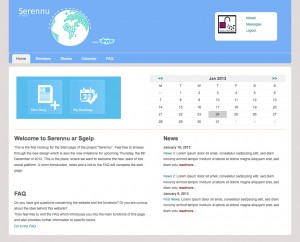My colleague Pekka from the University of Bremen has posted a series of useful reports on this site about the Application Partner Days, held as part of the Learning Layers project, funded by the European Commission IST programme.
Learning layers is aiming to increase the use of technology for learning in Small and Medium Enterprises in Europe, particularly through the use of mobile devices for informal learning in two ‘industry clusters, in the north German construction industry and in the medical sector in north east England.
Obviously such a project faces a number of challenges, given the slow take up of technology enhanced learning in SMEs. The Application Partner Days are designed to bring developers and researchers together with potential end users in organisations in the two sectors. And prior to the Application partner Days in north Germany, we also spent two days visiting companies and organisations in the sector responsible for education and training and for policy development in this area.
Rather than repeat Pekka’s excellent summary of the proceedings, I will offer a few observations, based on my own attempts to make sense of all we saw and of our discussions.
Firstly there is a perception that there are barriers to introducing technology for learning in small enterprises. But most people we spoke to were overwhelmingly positive about the potential especially of mobile devices. Although it was felt there may be some individual resistance, due to lack of familiarity or fears over privacy, in general it was felt that mobile devices would be easily accepted, especially by younger workers. Indeed, some people we talked to felt that introducing technology could make the construction industry more attractive and help overcome recruitment problems. The big driver for this seems to be the increasing everyday use of internet enabled phones. And flat rate data contracts mean more workers are prepared to use the ir own device for work purposes.
The issue of sharing between enterprises is more problematic. Some seem willing to share data, others less so. My impression is that this is a new situation where companies are undecided on the implications of sharing. And, of course there are worries over privacy and security, particularly and understandably in the medical sector. Interestingly, I was talking last weekend with someone responsible for the introduction of mobile devices in a major agency in the UK. One of their key requirements is that data is not held in the USA, due to fears over US security policies.
During the different workshop and focus group sessions we held in the Application Partner Days, we sought to gather ideas for applications which could be useful within the SMEs. A number of these =focused on better communication and information flows. The boundary between applications that support learning and those supporting communication and information exchange is becoming blurred. Better information provision can support informal learning but this may not be an automatic process.
Even though the Learning Layers project has relatively generous funding support from the European Commission, there are of course limits to what we can do. Even with the increasing functionality of Software Development Kits and frameworks, development takes time and resources. How do we decide what developments we wish to prioritise. And at the same time there is an avalanche of commercial applications being made available for both Apple and Android operating systems.
One answer may be to develop interlinked physical and on-line ‘Demonstration Centres’ which can bring together both relevant commercial Applications with apps produced through the Layers project.
A second approach may to to focus on boundary points. Obviously the medical and construction sectors both contain workers from different occupations organised through various structures and networks. These I would characterise as Communities of Practice. It is where innovations – both technical and social – occur that innovation occurs and new cluster emerge transcending the boundaries between traditional Communities of Practice and occupations and challenging existing occupational practices. It may be that it is at these points that the need for learning and new forms of collaborative working are at there greatest. Of course much of this learning is informal. And if the boundary points offer opportunities for the emergence of new innovation clusters, they may also serve to frustrate innovation where learning is impeded by existing organisational and occupational practices.
Lets try and provide a couple of examples to make this discussion a little less abstract! In the construction industry we can see a series of emergent innovation networks in the area of green or ecological construction. these involve collaboration by workers from different occupations using new materials, or old materials in new ways and developing new practices. Similarly, the use of Programmable Logic Controllers is crossing boundaries between programming and electrical installation. In the medical industry, we are looking at new practices and forms of organisation for supporting those with diabetes.
If we focus resources on such emergent practices, the result might be both to stimulate economic and social sustainability for small enterprises, to promote sustainable growth and the generation of new employment and at the same time support the development of knowledge maturing and informal learning within and between Communities of Practice.
Lastly but not least. The Learning layers project will run for four years and is keen to involve organisations and researchers interested in our work. You can sign up on the Layers website to become part of a Stakeholder Network, giving enhanced access to the work and to the applications being developed.



